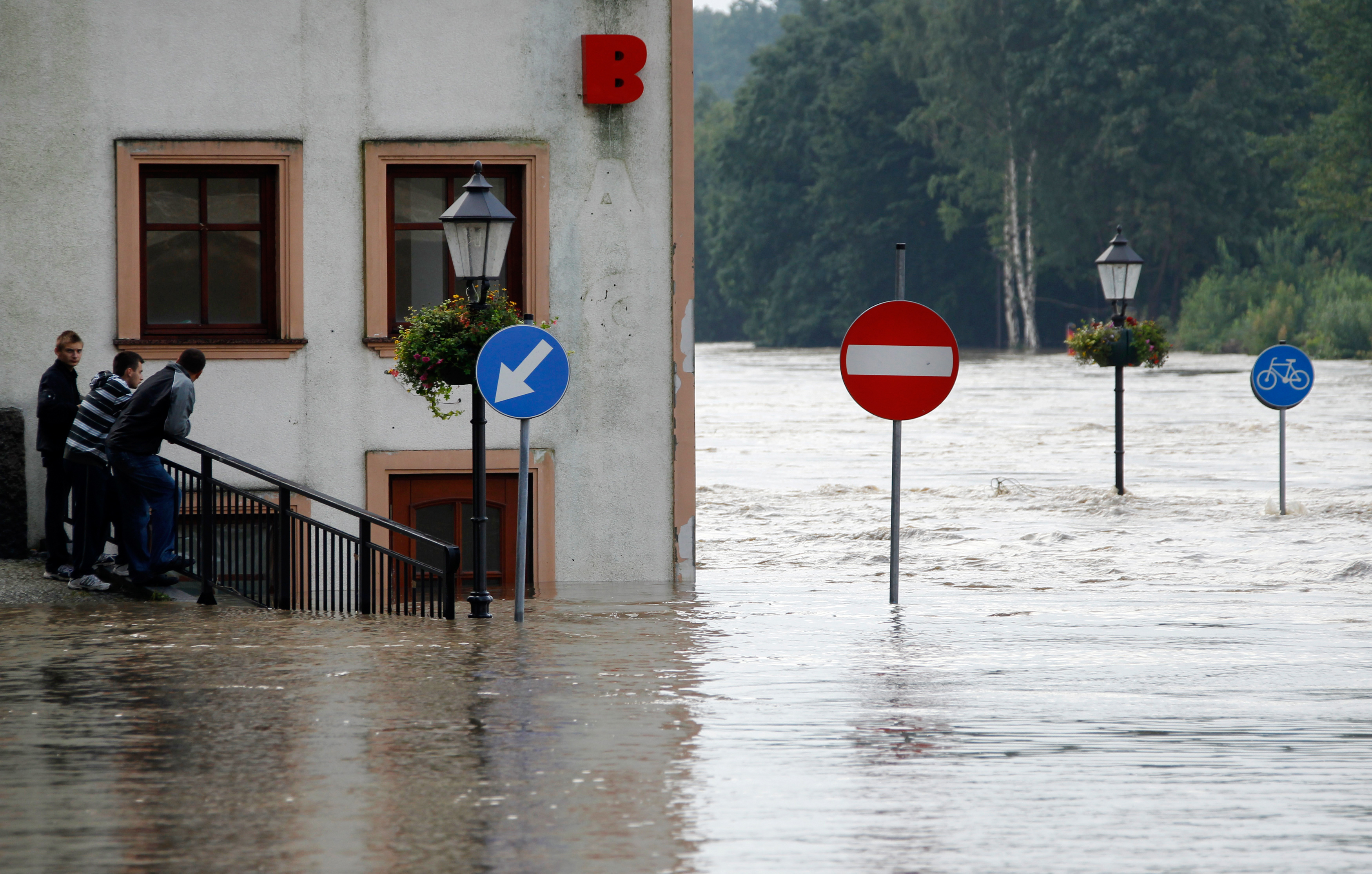Assessing flood risk inside Europe

A team of Polish and Swiss researchers are studying the risk of floods in southern Poland with a special focus on the role of climate change.
Scientists say two key culprits for devastating flooding over the past couple of decades are poor spatial planning and a changing climate.
Affixed to a building’s wall in the southwestern city of Wroclaw, a small metal plate, about 70 centimetres above street level, reads “13 July 1997 – water level during the flood”. This innocent-looking plaque, hardly visible to passers-by, encapsulates what some see as a defining moment for the city on the Odra River.
Heavy rains in the second half of June 1997 – pouring over vast areas in Germany, the Czech Republic and particularly in southern Poland – led to a flood of historical proportions. Water levels in the upper Odra River rose by four metres within 12 hours, inundating nearly 2,600 towns and villages with or without flood protection in place.
Nationwide, the traumatic event caused material damage estimated at around $3 billion (CHF2.75 billion) – approximately 1% of the Polish GDP at the time – and led to the evacuation of 162,000 people and the death of 54.
In Wroclaw, Poland’s fourth-largest city, flood protection failed and left around one third of the city area underwater.
Only seven years after Poland’s transition into democracy, the mobilisation of roughly 100,000 civilians and volunteers was an important moment for the community. A memorial that now stands by the University Bridge commemorates the victims and serves as a tribute to the collective cooperation to save the city.

More
Small countries can help combat climate change
Main natural hazard
Yet floods are not foreign to this central European country. Flooding is the main natural hazard in Poland, says Zbigniew Kundzewicz, head of the Climate and Water Resources Department at the Institute for Agricultural and Forest Environment of the Polish Academy of Sciences in Poznan.
“There’s no question that flood damage is growing everywhere [in Europe]. But to a large extent this is due to the fact that we have more to lose,” he says.
In part, economic losses from floods have increased because of growing wealth, but poor spatial planning has meant that more valuable infrastructure has been built in flood-prone areas, according to Kundzewicz.
“Rain of a particular intensity in the past may not have led to damage; now it does because the system is more vulnerable,” he says.
Damage from floods, he adds, could significantly worsen under the influence of climate change. Whereas floods normally occurred in Poland in summer, now they happen as early as May-June. The frequency of flash floods – unleashed by short, localised but intense rainfall – has also likely increased since 1995, research shows.
The FLORIST research project, a Swiss-Polish scientific collaboration, is intended to assess the risk from floods in the area north of the Tatra mountains. They will analyse processes at present as well as produce future projections under several climate change scenarios.
More specifically, the researchers intend to examine the possibility of floods – as well as intense precipitation and torrential disasters – changing in magnitude and frequency by mid-century and by 2100.
To do so, they will collect information from different sources – archival records, observation networks and field studies.
Their analyses will help better understand mechanisms of floods and the various weather conditions that could trigger them as well as those that already caused floods in the past.
Floods cannot be prevented, the study team stresses, but it is possible to minimise the damage. Conclusions from the study, they believe, could provide decision makers with a clearer picture of what to expect in order to improve preparations.
Risk assessment
Since the Second World War, Poland has seen “catastrophic river floods of regional extent” every 6.5 years on average, most of them triggered by rainfall, Kundzewicz wrote in a book published last year. The most recent occurrence was in May and June of this year.
The assessment reports which the Intergovernmental Panel on Climate Change (IPCC) are now beginning to release show floods are growing – by level of water and discharge – in most of the world, though not everywhere, says Kundzewicz, who also serves as a review editor for IPCC.
FLORIST, a joint project of researchers from Poland and Switzerland led by Kundzewicz, has been trying to assess flood risk in the northern foothills of Poland’s Tatra mountains, where high precipitation contributes to flood generation. The project is part of a larger Swiss-Polish cooperation programme.
“What we have in common is this mountain environment, here in southern Poland and in Switzerland,” says Ryszard Kaczka of the University of Silesia. “So the idea is to use Swiss know-how in Poland to examine flood risk in the mountains.”
Swiss view
Markus Stoffel and his team at the University of Bern have been studying floods and flash floods in the Swiss Alps. He says the FLORIST project offers them an opportunity to exchange knowledge and expertise with their Polish peers and also work in a different environment.
“The benefit for us is that in the Tatras the mountain torrents are not particularly channelled so they’re in a wild, natural environment. These are environments we do not often see in Switzerland [where] many torrents are not in their natural state.”
The contexts are different, Stoffel explains. Despite an increase in the number of floods since the late 1970s, Switzerland has seen fewer such events between the 1920s and the 1970s. But despite the differences, “in both contexts we see that climate change may affect the intensity of precipitations. We’re facing comparable problems”.
Regarding the prospects of addressing flood risk, Stoffel says “you can never manage a flood, but you can make sure that it doesn’t get too much out of control by taking the right actions before the waters arrive to the lowlands. Or at least to better plan evacuation in the future if you improve your understanding of how this flood wave propagates”.
For instance, he says that “in the mountains you might have opportunities – also in the foothills – to provide more space to rivers, to make sure that the flood wave can be attenuated so the peak discharge can be less high if you provide more space to rivers”.
Reminders
Poland is now working to implement the EU Floods Directive which would help the country better prepare. By putting numbers on the changes in flood risk, this study could inform decision-making, the team hopes.
The small plaque in central Wroclaw could be a warning sign for negotiators at the annual UN Climate Change Conference taking place in the Polish capital.
“From time to time we need a flood, because we forget it’s a risk,” Kundzewicz concludes. “So in all countries floods act as reminders that the risk is there and even if there is a long period with no flooding, one day a flood will come.”
Directive 2007/60/EC on the assessment and management of flood risks entered into force on November 26, 2007.
It requires member states to assess if all water courses and coast lines are at risk from flooding, to map the flood extent and assets and humans at risk in these areas and to take adequate and coordinated measures to reduce this flood risk.
The directive also reinforces the rights of the public to access this information and to have a say in the planning process.
Its aim is to reduce and manage the risks that floods pose to human health, the environment, cultural heritage and economic activity.
The directive applies to inland waters as well as all coastal waters across the whole territory of the EU.
(Source: European Commission)

In compliance with the JTI standards
More: SWI swissinfo.ch certified by the Journalism Trust Initiative









You can find an overview of ongoing debates with our journalists here . Please join us!
If you want to start a conversation about a topic raised in this article or want to report factual errors, email us at english@swissinfo.ch.